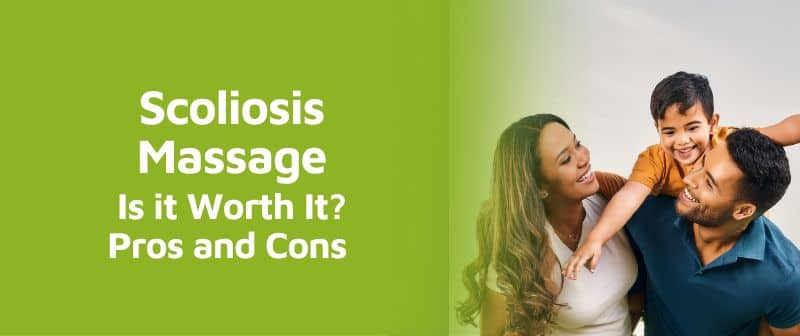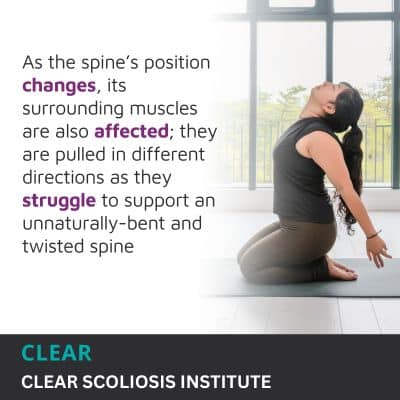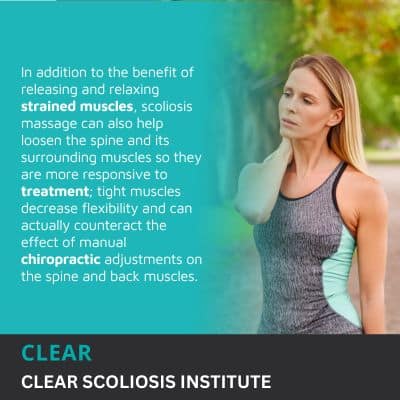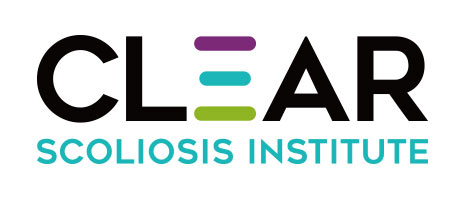
There is no one form of treatment capable of correcting scoliosis on its own; the condition is too complex and necessitates a multifaceted treatment approach. When scoliosis-specific, massage can help relax the spine’s surrounding muscles, making the spine and body more responsive to treatment, and providing pain relief.
There are a number of therapies that can be applied as part of scoliosis treatment and/or pain management. A general massage won't penetrate muscle tissue deep enough to impact the back muscles as needed, but a scoliosis massage therapist knows which muscles to target and how to reach them.
Before getting to the specifics of scoliosis massage, and the difference between a general and scoliosis-specific massage, let’s first discuss how and why scoliosis impacts muscles.
Scoliosis is a spinal condition that causes an unnatural and unhealthy spinal curve to develop, and a scoliotic spine also twists, making it a 3-dimensional condition.
In addition, scoliosis is a progressive condition, so it’s virtually guaranteed to get worse over time, and as this happens, the condition’s effects will become more noticeable, and the more a condition is left to progress, the more likely continued progression is as the spine becomes increasingly unstable/unbalanced.
In adults, the condition’s most-noticeable effect is pain, and this is because scoliosis becomes a compressive condition once growth has stopped: when skeletal maturity is reached.
In young patients whose spines are still growing, the lengthening motion counteracts the compression of the unnatural spinal curve, but once the spine stops growing, the condition’s uneven forces cause compression of the spine and its surroundings (muscles and nerves).
The uneven forces of scoliosis cause postural changes in children, as the most-noticeable condition effect, and this can include uneven shoulders, uneven shoulder blades, uneven hips, the development of an arch in the rib cage, and changes to balance, coordination, and gait can also be expected.
Adults will also experience postural changes alongside compression, but pain due to compression is the main effect, and this can involve back pain, nerve pain, and/or muscle pain.
So how exactly does scoliosis affect the back’s muscles?
Back muscles are important; not only do they support the spine, they also support the torso and facilitate flexibility/range of motion in the neck, arms, and legs.
Although scoliosis is a spinal condition, its effects can be widespread throughout the body; remember, the spine doesn’t just give the body structure, allow us to stand upright and move flexibly, it also works with the brain as the central nervous system (CNS), and works with the rib cage to protect important organs.
In order for the spine to function optimally as it was designed, it needs to maintain its natural curves, and this means its individual bones (vertebra) are aligned and stacked on top of another as they should be: in a neutral and straight alignment.
As scoliosis gets worse, the size of the unhealthy spinal curve is increasing, and this means the uneven forces are also increasing; a goal of conservative treatment is to work towards preventing progression to minimize the condition’s effects.
Scoliosis doesn’t just affect the spine, but also its surroundings, and the spine and its surrounding muscles have to work together to maintain spinal alignment.
So what happens to the spine’s surrounding muscles as an unnatural spinal curve develops and progresses?
In addition to pain and postural changes, scoliosis is also associated with the development of a muscular imbalance.
A scoliosis muscular imbalance is a common effect, particularly in cases that are severe, left untreated, or not treated proactively.
A scoliosis muscular imbalance means the back will be strong on one side and weaker on the other; scoliosis is an asymmetrical condition capable of disrupting the body’s overall symmetry in different ways, including its muscles.
Being proactive is important because although scoliosis is incurable, many cases can be highly treatable, particularly with early diagnosis and intervention.
As the condition’s effects become more overt over time, why not start treatment early before the effects are severe and established; it’s generally harder to reverse a progressive condition’s effects than it is to prevent them from developing.
As the spine receives support and stability from its surrounding muscles, what happens to those muscles as the spine starts to bend and twist unnaturally?

Muscles on one side of the spine can become strained and sore from overuse, while muscles on the opposite side can become weak from underuse; both over- and under-used muscles can become problematic.
In most cases of typical idiopathic scoliosis, curves will bend away from the heart, to the right, and this means that the muscles on the right side of the curve will have to work harder to counteract the unnatural bend, and as they are overused, they can become stretched, strained, and sore.
The muscles on the left side of the spine, over time, can become smaller, weaker, and tighter due to underuse.
What a lot of people do when they have sore muscles is get a massage, but what about people with scoliosis? Is massage helpful, hurtful, therapeutic?
As non surgical conservative scoliosis treatment focuses on reducing the size of an unnatural spinal curve while also impacting the spine’s surrounding muscles by making them stronger, it makes sense that massage could have a place in the care and treatment of scoliosis patients.
Just as the complex nature of scoliosis requires treatment from a scoliosis specialist, massage also has to be scoliosis-specific to offer any type of long-term benefits.
With most general massage, a massage therapist is not going deep into the muscle tissue, but is more so massaging a muscle’s surface; what scoliosis patients need for any lasting long-term results is a deep-tissue massage capable of releasing overworked spasming muscles.

A scoliosis-specific massage therapist will understand muscles, scoliosis, how one affects the other, and how best to counteract the condition’s negative effects.
In most cases, the muscles that extend along the inside of a scoliotic curve are going to be excessively loose, so these muscles can be highly sensitive to deep massage, while the muscles on the curve’s outer edge are likely to be excessively tight, so can benefit from care to ensure they won’t pull the spine further out of alignment; a scoliosis-specific massage therapist will understand how to approach affected muscles differently for the best potential results.
Scoliosis massage can help with short-term pain relief, but for any type of long-term relief and/or therapeutic benefits, scoliosis-specific massage is needed, and should be integrated into a proactive conservative treatment plan.
As a structural spinal condition, condition-specific chiropractic care works towards impacting the position of the spine’s vertebrae, while physical therapy, scoliosis-specific exercise, and a variety of therapies, including scoliosis massage, can help relax the spine and its surrounding muscles so they are more responsive to treatment.
Part of treatment also involves addressing any related muscular imbalance, and scoliosis massage can help keep the muscles loose and relaxed so they are more responsive to treatment.
When it comes to pain management for adults, scoliosis massage can help with long-term pain relief, particularly when combined with other forms of corrective treatment such as chiropractic care, physical therapy, and scoliosis bracing.
General massage for people with scoliosis can offer little more than short-term pain relief, but scoliosis-specific massage can offer therapeutic benefits that include keeping the spine’s surrounding muscles loose and relaxed so they are more responsive to treatment; healthy back muscles mean optimal spinal support and stabilization.
In addition, in people who have experienced significant progression, sometimes work needs to be done before applying chiropractic care to ensure the spine and its surrounding muscles are going to be as responsive as possible, and scoliosis massage can help release and relax strained back muscles.
As a CLEAR Scoliosis Institute chiropractor, I believe in the power of a conservative treatment approach that integrates a variety of treatment disciplines and therapies in an attempt to impact conditions on multiple levels.

CLEAR provides a unique and innovative way of understanding scoliosis. Sign up to receive facts and information you won’t find anywhere else.
